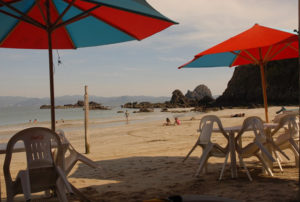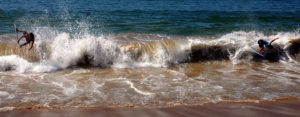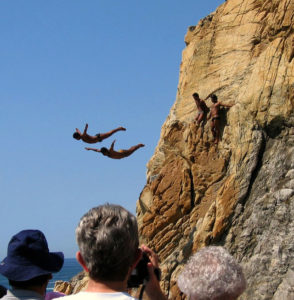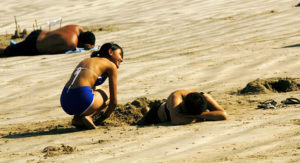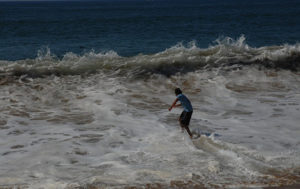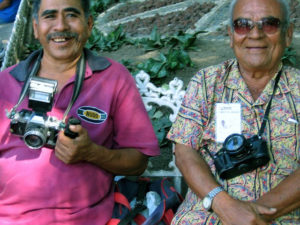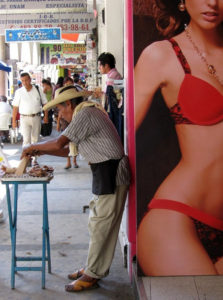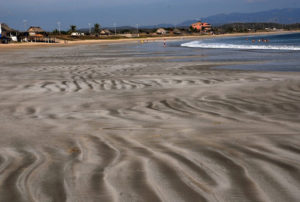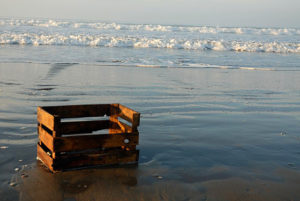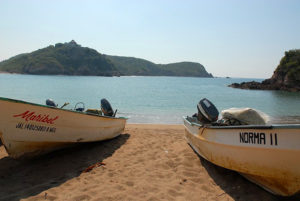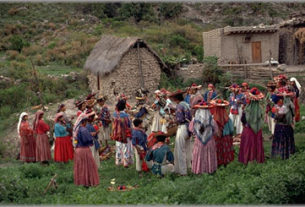The Months of Mexico
Tomorrow’s champions are at work here, at Bahía de Navidad.
In the hot afternoons along the wave-thumped beach of Melaque, lithe brown bodies dash along the alternately stirred and subdued sand and launch themselves at the sea.
The steady winter sun descends in its unwavering plunge into a horizon washed faithfully by varying hues of reds and yellows. Sometimes a “green flash” winks, and is gone.
The boys run with their boards in their hands and, having selected the right wave, they flick the skin-thin boards into the fragile film of a receding wave to meet the oncoming wall of water. If they catch the wave skilfully, the skimboard is pivoted by their strong limbs and they pirouette in an air-mixed broth of water and sand, and triumphantly ride their steeds back to the beach.
The best of these – the championship contenders – are the budding Nureyevs of the surf. The sea is their stage. Their peers, for now, are the audience; spectators that judge, too, though not harshly. That will come later, when they’ve honed their pre-teen skills and grown their muscles.
For now, they are revealing their best in a bid to qualify in a few years for the skimboard world championship playoffs, which are held here every January following an elimination round in Acapulco. The winner here collects $5,000 pesos and a chance to represent Mexico in the national championship held in the bigger surf of Cabo San Lucas and on to the world championships at Laguna Beach, California.
In the crowd watching the competition, held mid-way between one end of this half-moon beach at Melaque and the other end at Barra de Navidad, are many of the hundreds of tourists who come here for the sun, sand and (some of them) the surf. The Melaque beach is protected by a spine of guano covered rocks on the northwest, and the surf there is quiet; Barra is tucked into the lea of a muscular bulge of hills but it is open to the ocean swell, and the surf is challenging for unskilled swimmers. Surfboarders play here. In between these two communities and in the middle of the swoop of Christmas bay, the skim board contestants gather for their annual showdown.
And while the confident sons of Melaque hone their skills and their older brethren challenge each other for the top prize, the tourists soak up the rays.
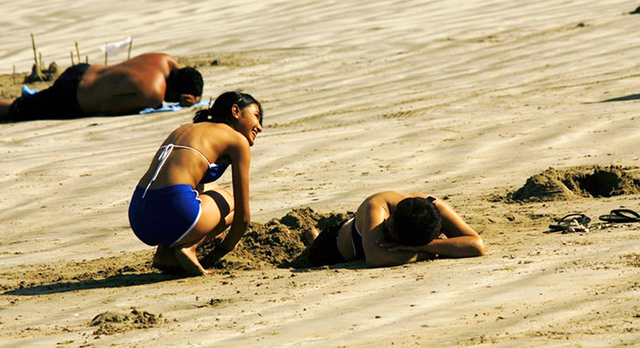
Beach vacations South of the Border
There are many famous beach destinations in Mexico. Cancun, Acapulco, Mazatlan, and Cabo san Lucas among the most distinguished. These are magnets for the sun-starved denizens of the northern climates of North America and Europe who revel in the sumptuous warmth of the sun and the sea, and the companionship of other all-inclusive people like them. It’s a social comfort zone in a natural southern sauna.
However, there are many less-known but not necessarily lesser beach destinations that are seasonal destinations for Mexicans who live in the high plains and mountains of this roller coaster country where winter temperatures commonly dip to near zero at night. Bound for the surf ‘n sand, the middle classes crowd into their SUVs whose stability is compromised by overloaded roof racks festooned with beach toys for the kids and dads, umbrellas, folding canvas chairs, portable barbecues, drink coolers and even tents.
Those Mexicans of a lower order who don’t own their own vehicles or whose autos might not survive mountain pass journeys down from Guadalajara, Mexico City or other winter-chilled interior cities arrive in their hordes jammed like canned sardines into second-class tour buses that made the run overnight so that the sleepless seekers of the sand can waste no time immersing themselves in a weekend of saltwater soaks, tequila quaffing, taco gulping and late night group singing to the accompaniment of a guitar or accordion.
It’s great fun for them and amusing for those of us who are fortunate enough to be able to vicariously participate in these holiday debauches. Mind you, there always is a grumpy contingent of just-arrived Canadians or Americans who complain about those noisy, socially uncouth Mexicans.
These places are everywhere along the Pacific coast, varying from those created specifically for the Mexican tourist, such as Rincón de Guayabitos in Nayarit or Huatulco in Oaxaca to other beach towns which gradually emerged from sleepy fishing villages such as Melaque, Jalisco, into sought-after destinations for Mexicans and gringos alike.
Some of these places offer desirable features – surfing, snorkelling, entertainment options – but all that is needed for a Mexican who’s got the gift of his own week during Christmas or Easter when the kids are out of school are family and friends surrounded by sun, sand, surf, sea salt – and seafood.
A surfeit of seafood
At the beach, Mexicans can always be observed joyfully tackling serious mounds of shrimp, prawns, octopus, clams, lobster and fish. Although undeniably they love their meat, preferably tucked into a tortilla, they are supremely passionate about seafood. There is a pre-Hispanic history of series of runners overnight bringing freshly harvested fish and crustaceans from the Gulf of Mexico to the Aztec rulers and other rich citizens of Teotihuacán, the greatest city in North America at the time.
Mexico employs a large fleet of trawlers which dredge up vast quantities of shrimp and prawns, quick-frozen for the waiting consumer inland. But along the villages of the Pacific, greater numbers of pangas – sea-going launches with one or two men aboard – fish by hand line for red snapper, dorado or tuna. They also fish inshore by set net for varieties of other species. Like the Mexican, it is upon any of these that we feast: caught overnight they are brought to our fish mongers first thing in the morning, pan-ready and glistening with freshness and robust with firmness. It is wise to get there early, for the best of the daily catch. Expect to get in line.
Tenacatita for surf
Tenacatita, an hour north of Melaque, is one of the most popular beach destinations at any time, and invariably during the Mexican religious and state holidays. Its surf is rarely rough, its water constantly warm and the sole-massaging sand stretches in a wide, welcoming wedge to a far-distant surprise of rocks behind which spreads another seeming never-ending arc of yellow sand to La Manzanilla.
If one arrived at Tenacatita — as I first did back in the early ’90s in an inflatable craft through a mangrove waterway near where I had anchored my sailboat — he would know immediately that this is a sun/surf/swim/sea salt/seafood haven. This would be obvious even if the beach were that day unaccountably deserted. For half a mile, the beach is populated by palm-thatched palapa restaurants, every one of them offering the locally-famous seafood dish, rollo del mar: a thin-sliced wrap of white fish stuffed with shrimp, cheese and whatever other sea delight the chef had at hand that moment; a heavenly sauce smothers the roll. Many enjoyable hours can be spent at table there, ordering a stream of dishes and drinks as the sun settles crimson in the strawberry west.
The beach is a circus promenade of colourful tents shielding brown bodies from the forever sun. Picnic baskets abound under these shelters and Styrofoam coolers keep beer, Sprite, Coke and other unhealthy, sugary liquids at just the right temperature. There are at least two dozen restaurants there and every one of them has at least a dozen tables. At the holiday times, all of these tables unfailingly are occupied. The people order food and drink from the menu, or they might just pay a fee to the proprietor for the table and chair and eat their own picnic lunches. There is much drinking, and no violence that I have ever seen. But I usually am long gone before night-fall, so who knows what those empty bottles might precipitate?
But there’s more to the Mexico seashore than skimboards, seafood and sun-bathing bronzed bodies: there is solitude. There are vast stretches of uninhabited or unfrequented beaches lounging serenely beside a roiling sea that stretches westward seemingly into infinity. During our many Months of Mexico, we have driven virtually all of the Pacific Ocean from where the Colorado River enters the Sea of Cortez (a mere trickle now as the parched and populated U.S. southwest drains off virtually all of its life-force) to the Isthmus of Tehuantepec, near the Guatemala border, and on to the Gulf of Mexico. From the salt-water stained windows of our well-travelled VW campervan – named Frida after the revered and irreverent Mexican artist Frida Kahlo – we have seen sand and surf that have rarely felt the heavy tread of man.
The coastal highway
High up where Highway 200 snakes above the cliffs, Frida clings to the tree clad mountainsides as over and over again she pants up innumerable steep inclines and breathlessly swoops down the other side. From this sky-high, two lane collarbone of asphalt, we gaze at the spectacular congruence of crashing sea and submissive shore. If only there was a place to pull over! But the lay-bys are rare and, even then, the pavement drops off so precipitously to a narrow wedge of gravel that a car’s under carriage could be damaged. Then there’s the garbage…. It is there almost always in great quantity, especially where there is the hopeful printed admonishment: No tire basura (Don’t dump garbage here).
Although there are few opportunities to leisurely take in the scenery, the twists, turns and steep climbing grades of this mountainous road ensure slow going – averaging 30 km an hour. Driver and passenger thankfully are afforded an opportunity to sneak occasional peeks at the spectacular vistas. Three major tourist centres along this route present beach buffs with the usual options: Zihuatanejo, Acapulco and Puerto Escondido are destinations both for the all-inclusive crowds, dedicated sun worshippers and the inevitable surfer dudes. We have spent time in all of these cities, but would rather pitch tent in a desirable cluster of Oaxaca beach towns known collectively as Puerto Angel, the largest town in the area, farther down the road.
Puerto Angel
As far as I could tell, the fisher folk, merchants and collective community of neat and tidy Puerto Angel (An-hell-ians?) were a serene and traditional lot, what with their time-honoured status as an unpretentious fishing village – and unseemly, out-thrusting fishing pier to nowhere.
The pier, whose presence is perplexing to the uninformed, harks back to a time when lumber and coffee were king – or at least princely – in the state of Oaxaca. It was built to accommodate seagoing freighters that transported the coffee beans as well as lumber to export markets. At a time in the late 19th century when no viable roads, save for a dusty serpentine track, led to Puerto Angel, hill-dwelling peons would descend to the sea leading their heavily-laden burros to the ships. Alas, lumber is not an easily-renewable resource and once it’s gone, it’s gone for a long time, unless there is unlikely foresight to replant the ravaged slopes of this tropical forest. Meantime, the world coffee scene shifted, leaving Mexico – and the pier at Puerto Angel – proverbially hung out to dry.
In the southern sun, the concrete hulk languishes, useless to the local panga fishermen and useful only for a short stroll to the end. It was badly damaged by Hurricane Pauline in 1997 and inexplicably, considering its sorry past, rebuilt two years later, to resume its accustomed role as an incongruous, crumbling cement hulk.
Although there may have been rationale in the 1800s for the construction of the pier, initiated by Oaxaca-born President Benito Juarez, its reconstruction was another ill-considered venture of Federal District bureaucracy to inject life or at least hope into yet another “floundering” seaside economy. I suspect that in many places in the world, there is a contingency of bureaucratic sleuths poised to pry into the humble affairs of perfectly content people living a simple life replete with ample food, joyful song, tender love, mutual respect and traditionally devoid of intervention from abroad or above. These well-meaning interventionists, after some deliberation, would declare portentously that this citizenry were in dire need of the assistance of the state. Meetings would be called, consultations held and eventually decisions taken that may or may not baffle the recipients of the state’s solicitousness: ie, a pier to nowhere which if from a distance a bemused observer squints his eyes while gazing at the otherwise stunning scene could, just barely, rid the hulk from consciousness for a second or two.
Fortunately the overall landscape is enhanced by the beauty of the bay and the serenity of the scene where the picturesque town looks down on the beaches where fishermen land their catch, where their restless pangas lie at anchor and where around the corner yet another glinting Costa Chica crescent of sand lies to capture the fancy of local Sunday sunbathers and beach-crazy visitors from more distant places.
We chatted with two fishermen who were tending to their nets at the end of their day, even though it was only mid-morning. We exchanged information about their part of the Pacific Ocean and ours, way up north in Canada’s Province of British Columbia. Much colder, we agreed. Tuna, red snapper, shark and other silvery species were among the fish available from freezers set back from scale-flecked wood tables where fisherwomen were cleaning and storing the last of the day’s catch. We purchased half a kilo of red snapper for our evening meal. It was so fresh that its delectability was a foregone conclusion: we could hardly wait for the confirmation that would come with the first touch on the tongue.
The nude beach at Zipolite
I suspected that Zipolite beach down the road might be a different story, considering its well-known positioning as a nude beach. I can’t confess to know much about its night life, but what do parading exhibitionists do after the sun goes down and there’s no way to display their non-fiscal assets? Surely things raunchy, or at least naughty.
We chose a campground a pebble’s toss from the beach, next to two middle-aged guys from Canada who, it turned out, were there for the nudist scene. That was a bit of intelligence we ferreted out, not by their confessions or concessions, but by simple default: late in the afternoon we saw them naked on the beach, at least bold if not bronzed. A long way to travel, I thought, just to be able to capture the full 100 per cent vitamin D benefit of the sun’s rays. Zipolite is not exclusively a nude scene; in fact, the majority of the sun worshippers and swimmers there were attired in conventional beachwear.
All of this we observed as we caught up with our computer on deferred world events and family affairs in a palapa internet café/restaurant/bar on the beach. From the edge of the sand, a 50ish guy resplendent in a pinkish birthday-suit display of genitalia and slight paunch unabashedly strolled from a beachside cabin to study for several long minutes a menu board displayed at the entrance. The offerings of this menu board, I presumed because of the degraded print much-faded by the sun, never changed; so I wondered why a person who’s been around, naked, for several days would need once again to peruse it so intently before the eyes of fully-clothed people seated in the restaurant. This unsolicited theatre, devoid after a minute or so of any arresting entertainment value, served only to create some discomfiture among the diners who felt obliged studiously to keep their eyes focussed on their plates, considering the unexceptional option. Nudists as exhibitionists, I reckoned.
On this day we observed a few sunbathers catching the late afternoon rays. Except for the flasher, there was nary a nudist in sight so I bent to my tasks at the computer.
A few moments later I glanced up to see a couple of 20-something girls slip out of their bikinis and dash to the surf. It wasn’t quite like the bronzed boys of Melaque sharpening their skimboard skills in the waters farther north. But the thin slanting rays of early evening did catch the flash of the girls’ ivory bodies descending to the water where they gaily kicked through the surf froth and dove au naturel into the all-concealing southern sea.

